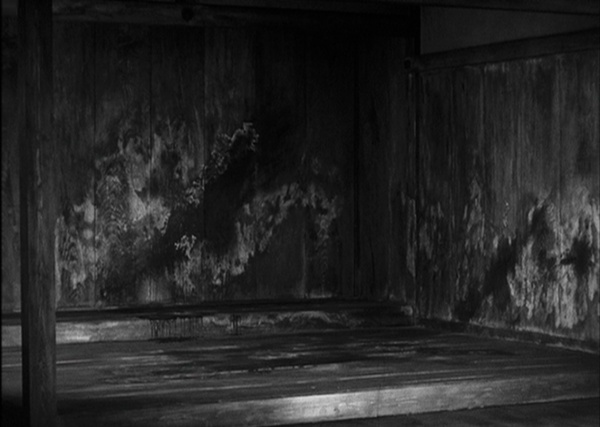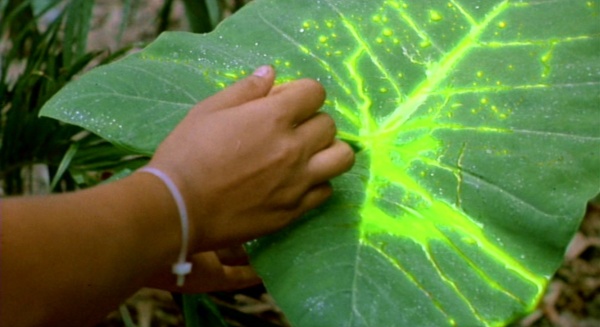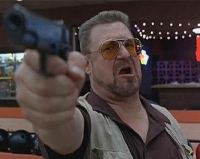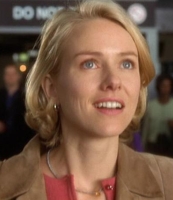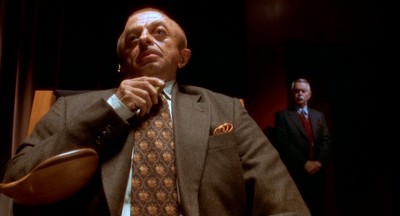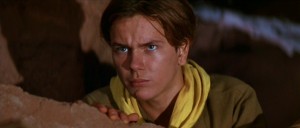[This post is a part of the Movies About Movies Blog-a-Thon, hosted by goatdogblog.]
[Note: This essay contains spoilers. It assumes a basic familiarity with interpretive approaches to Mulholland Drive, particularly the "Classical" reading. See the Lost on Mulholland Drive clearinghouse and the vital Salon piece, "Everything You Were Afraid to Ask About Mulholland Drive".]
Although Inland Empire comprises the most direct examination of movie-making (and -watching) in David Lynch's filmography, Mulholland Drive has always struck me as offering a slier, more cutting indictment of Hollywood and the mythology that clings to it. One of the most intriguing demonstrations of this impulse is MD's depiction--via an actress' guilty fever dreams--of the studio film-making apparatus as a rotten entity riddled with conspiratorial forces. Within Diane Selwyn's schizophrenic fantasy, strange men move to quash the ambitions of promising actors and rebellious directors, their motives hazy but always sinister. Wracked with despair over her own professional and personal failings, Diane gives a dread life to our collective paranoia about the film industry. The shadow Hollywood she summons is by all appearances occupied not with high art or even vulgar entertainment, but with control over messages, money, and especially lives.
There are numerous conspiratorial currents flowing through Diane's fantasy, some explicitly connected to her shadow Hollywood, some connected only through implication and suggestion. The paranoia that suffuses the fantasy rests on the premise that dangerous conspirators seek to harm or hinder Diane's avatar "Betty," her lover Camilla's avatar "Rita," and an incarnation of director Adam Kesher. Oddly, it is Adam that falls victim to the brunt of the conspiracy's wrath rather than Diane's own avatar. In reality, Adam is the man who initiated a relationship with Camilla, "stealing" her from Diane. And yet Diane casts him as a sympathetic victim in her fantasy, albeit one who finally crumbles and acquiesces to the conspiracy's wishes. In this way, Diane revels in the violence done to Adam's career, marriage, and body, while painting him as ultimately weak and beholden to powerful forces. Within her dream, she has her revenge, without placing Adam into the role of the villain. The real villains of her fantasy are the men of shadow Hollywood.
There are numerous acts of violence, enigmatic messages, and strange meetings in MD, but only a handful of these conspiratorial sequences alight directly on film-making. One such event is the meeting between Adam and Luigi and Vincenzo Castigliane, a meeting whose purpose Adam initially does not comprehend. It's an odd scene in a film filled with odd scenes, but its black humor evinces rich layers of meaning. The Brothers' names and Luigi's preference for the finest espresso implies that they are Italian, and the other participants at the meeting seem nervous around them, evoking the specter of organized crime and an attendant threat of violence. (Never mind that not all Italians are gangsters. This is Diane's fantasy, seen through the a haze of her Hollywood daydreams, and in such a world gangsters are always Italian.) More generally, it is not without significance that the Brothers are foreign or at least of foreign extraction. They are an alien influence reaching into Hollywood, that most American of institutions. In envisioning the men of shadow Hollywood, Diane swaps the more traditional slur of conniving Jewish money-men for that of Italian gentlemen-thugs, one of MD's numerous nods to hardboiled or noir traditions. Although, as we will see with the Cowboy, other conspirators are uncannily All-American.
